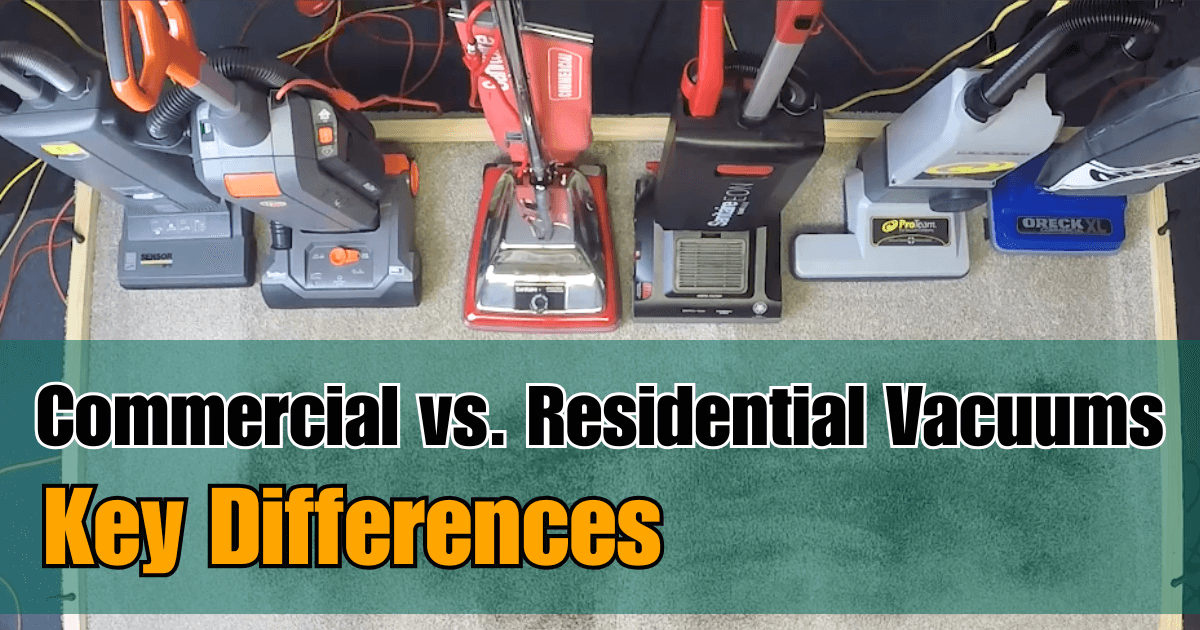Vacuum cleaners come in many shapes and sizes, but not all are built for the same purpose. Residential vacuums are designed for typical home cleaning – light, convenient, and feature-rich for everyday messes. Commercial vacuums, on the other hand, are built to endure the rigors of offices, hotels, and industrial spaces – prioritizing durability, power, and efficiency over bells and whistles. In this comprehensive guide, we’ll compare all major types of vacuums (upright, canister, backpack, robotic, handheld, etc.) across commercial and residential categories. We’ll dive into differences in design, durability, features, weight, power, noise, filtration, maintenance, and pricing. We’ll also highlight examples from leading brands like Hoover, Bissell, Dyson, Shark, Sanitaire, ProTeam, Nilfisk, and more. Along the way, we include performance data, real customer reviews, and expert commentary – including insights from Chris White of Vacuum Wars – to give you an informed perspective.
Major Types of Vacuum Cleaners
Both commercial and residential vacuums come in various form factors. The key types include upright, canister, backpack, stick/handheld, and robotic vacuums. Let’s examine how each type is used in home versus business settings:
Upright Vacuums
Upright vacuums are the classic all-in-one design with a motor and brushroll in the base. They are popular in both homes and commercial settings, but there are stark differences in build and capabilities. Residential uprights (e.g. Dyson Ball or Shark Navigator series) often feature swivel steering, bagless dust bins, and multiple attachments for versatility. They’re designed to be user-friendly for homeowners – easy to maneuver around furniture and effective on both carpet and hard floors.
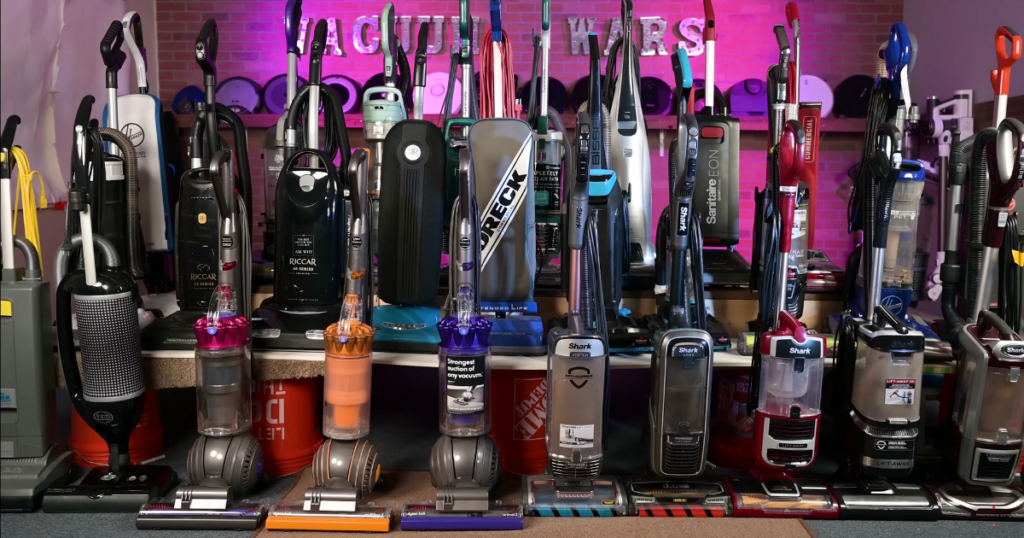
Commercial upright vacuums, by contrast, are typically more rugged and no-frills. Many commercial uprights (e.g. Sanitaire Tradition series or Hoover Commercial models) use durable metal components, extra-long cords, and simple mechanical switches. They often have big bag capacities and strong single-purpose performance (usually optimized for deep carpet cleaning) [thinkvacuums.com]. For example, a Sanitaire commercial upright might have a 12″ wide cleaning path, a 50-foot cord, and a high airflow motor – great for covering large areas of carpet quickly [thinkvacuums.com].
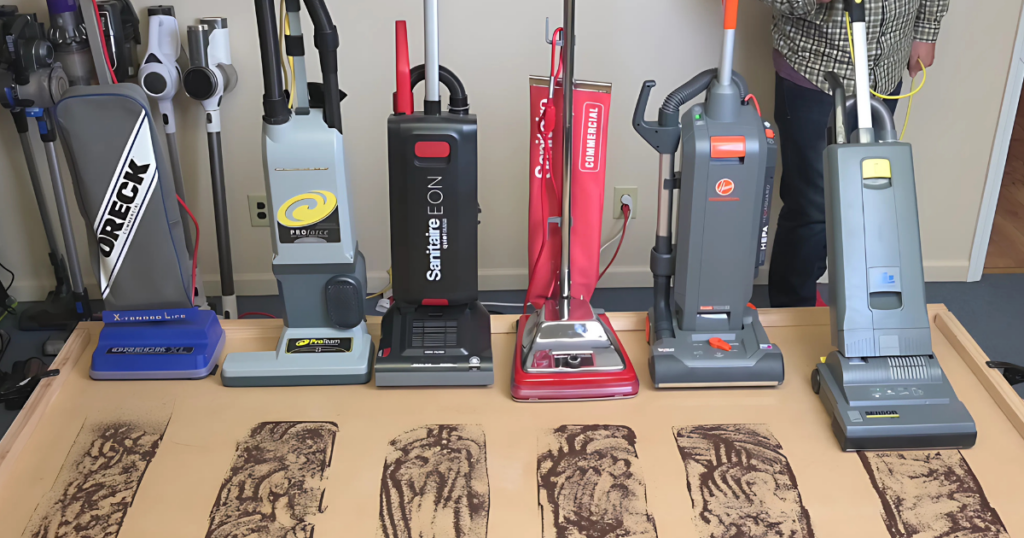
However, these tend to be heavier and lack some conveniences (like swivel steering or automatic height adjustment) found on residential uprights. Upright vacuums remain the workhorse in many environments: in homes they balance power and ease-of-use, while in businesses they emphasize reliability and speed for large floor areas.
Canister Vacuums
Canister vacuums have a separate canister body (with motor and dust container) attached to a cleaning wand via a hose. In residential use, canisters (like Miele or Bissell models) are favored for their flexibility – they excel on hard floors and above-floor cleaning with various attachments. Home canister vacuums are often designed for quiet operation and high filtration (some high-end models have HEPA filters and sealed systems for allergy control). In commercial settings, canister vacuums are also common, especially in Europe and professional cleaning crews.
Commercial canisters (for example, the Nilfisk GD930 or Numatic “Henry” vacuum [watch our review]) usually have a larger capacity and extremely robust construction (often a tough plastic or even metal body) to survive daily use. They might not be as quiet or sleek as residential models, but they can run for long periods and hold a lot of debris. Many commercial canisters prioritize function over form – long hoses and power cords, simple on/off controls, and compatibility with HEPA filters or specialty bags for fine dust. Both home and commercial canister vacuums are versatile on multiple surfaces (carpets, hard floors, upholstery), but the commercial units sacrifice a bit of ergonomics and appearance to maximize durability and capacity. [blog.mastercraftusa.com]
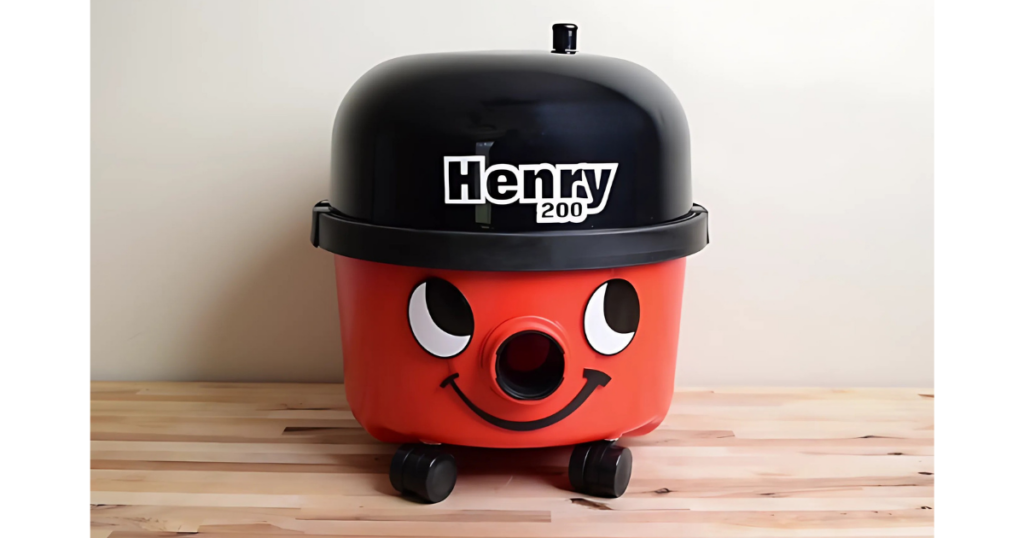
Backpack Vacuums
Backpack vacuums are a subset of canister vacuums designed to be worn like a backpack. These are rarely used in ordinary homes but are very popular in commercial cleaning (janitors, custodial staff, etc.). The concept is to allow the user to move freely without dragging a canister or pushing a heavy base – the vacuum canister (usually a cylindrical unit) straps onto the operator’s back, and they use a long wand to vacuum floors, corners, and even ceilings. Commercial backpack vacuums (like the ProTeam Super CoachVac or Hoover Commercial HushTone Backpack) are valued for productivity: a person can cover 2-3 times more floor area in the same time compared to using an upright [corvusjanitorial.com]. They tend to be lightweight for their size (typically around 10–12 lbs carried on the back) and are designed with ergonomic harnesses.
These usually come with HEPA-level filtration to protect air quality in offices and schools [blog.mastercraftusa.com]. In residential use, a backpack vacuum is overkill unless you have a very large home with few electrical outlets; most homeowners find canisters or uprights more convenient. But for commercial crews cleaning large buildings or multiple floors, backpacks are a game-changer in maneuverability. The trade-off is that they require training to use (managing the cord and hose on your back) and typically don’t include motorized brush heads (they rely on suction and floor tools), so they may not deep-clean plush carpets as well as a powered upright.
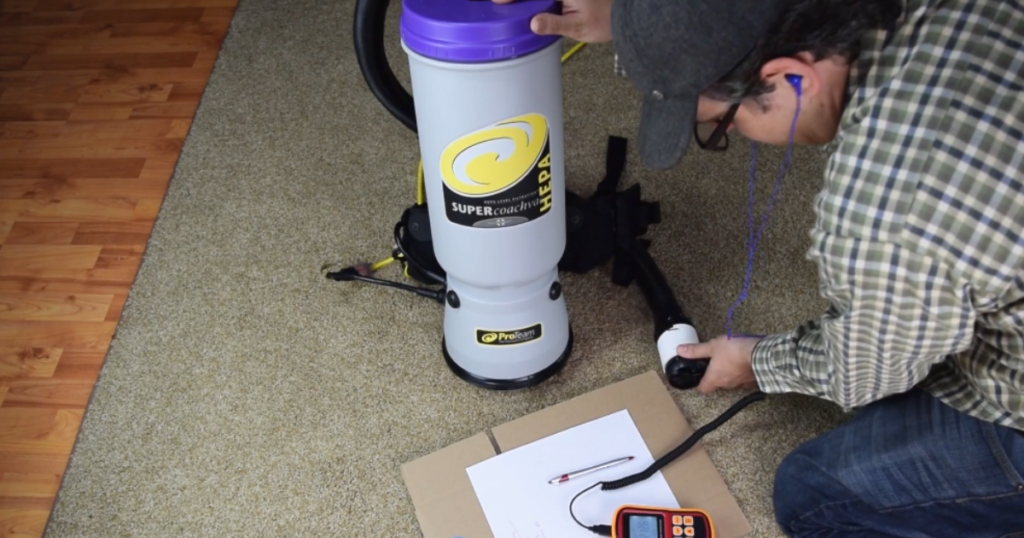
Stick and Handheld Vacuums
Stick vacuums (also known as corded/cordless stick vacuums or “electric brooms”) and small handheld vacuums are very common in homes and almost exclusively residential. These include popular battery-powered models like the Dyson V-series or Shark cordless vacuums, as well as tiny “dustbuster” hand vacs. Their strengths are convenience and quick cleanups – they are lightweight and easy to carry [thinkvacuums.com], often convertible to handheld units for above-floor cleaning. Residential stick vacuums have seen huge technological innovation (powerful lithium batteries, brushless motors, even smart sensors that adjust suction).
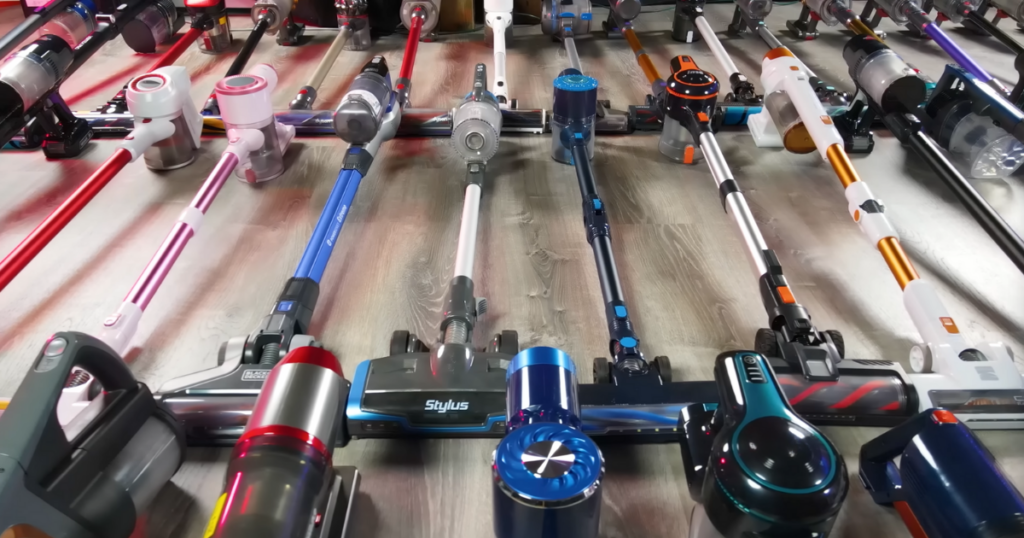
In a commercial context, however, stick/handheld vacs play a minimal role. Cleaning crews can’t usually rely on battery vacuums for large areas due to limited runtime, and the smaller capacity would require frequent emptying. That said, some businesses might keep a cordless stick vac on hand for quick touch-ups or stairs, but they wouldn’t use them as primary floor cleaners. Commercial-grade stick vacuums do exist (for instance, Hoover Commercial has a cordless upright and Sanitaire offers a commercial stick), but they are basically crossover products for light-duty use. Generally, home users benefit most from sticks/handhelds for convenience, while businesses stick to corded machines for serious cleaning.
Robotic Vacuums
Robotic vacuums have exploded in popularity for home use in recent years. Autonomous cleaners from brands like Dreame, Roborock, Eufy, Ecovacs, or more, can patrol household floors, keeping dust and crumbs at bay with minimal human effort. In residential settings, robots are ideal for everyday maintenance – you can schedule them to clean while you’re at work, and many have smart mapping, obstacle avoidance, and auto-docking to recharge.
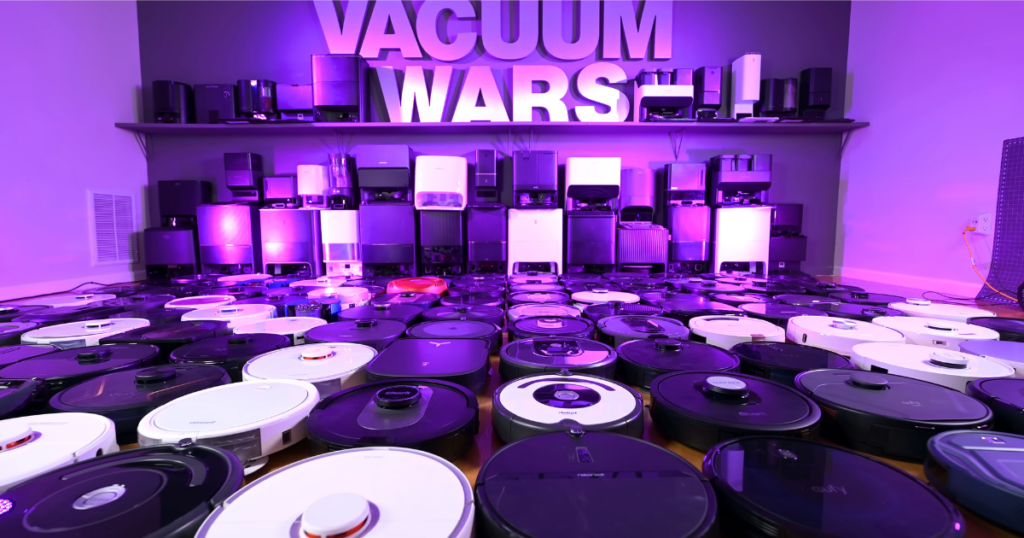
When it comes to commercial use, robotic vacuums are still an emerging niche. A few specialty models exist for businesses (e.g., Makita’s robot vacuum, or larger robotic scrubber-vacuums used in big facilities), but these are not yet as common as their residential counterparts. Businesses often have large, open areas that require more robust machines (or simply a human for flexible cleaning). Additionally, issues like stairs, complex layouts, or the need to thoroughly clean corners mean a human-operated vacuum is usually preferred in commercial spaces for now. Still, as technology advances, we are starting to see robots in settings like hotels and office hallways for off-hours cleaning [marketresearchintellect.com].
For this article’s scope, we’ll focus mainly on the traditional vacuum types (upright, canister, etc.) where the bulk of commercial vs. residential differences lie – but it’s good to note that the cutting-edge in home cleaning (robotics, smart vacuums) hasn’t fully translated to the commercial world yet.
To put it simply, commercial = heavy-duty performance for the big jobs, residential = versatile performance for mixed tasks.
Design and Construction Differences
One of the first things you’ll notice comparing a commercial vacuum to a residential model is the design and build quality. Commercial vacuums are truly built for work: they are often larger, heavier, and sturdier in construction. For example, a commercial upright may use a metal base plate, metal brush roll, and thicker plastic or even steel parts, whereas a residential upright might use lighter-weight plastics to keep it portable. According to Bissell’s commercial division, professional cleaning equipment is designed to be “dependable & durable” because it sees much more frequent use and often must clean “much larger spaces” than a typical home vacuum [bissellcommercial.com]. In a hotel, a vacuum might run for hours a day across dozens of rooms, so its components (motor, fan, belts, housing) need to withstand that duty cycle.
Size & Weight
Commercial units tend to be bulkier. They often have wider cleaning heads to cover more floor with each pass (some wide-area commercial vacuums can be 2–3 times the width of a standard home vacuum)[blog.mastercraftusa.com]. They also include larger dust bags or bins (more on capacity later), which add to size. The weight of a commercial vacuum is typically higher than a residential model in the same category – often intentionally. Heavy-duty materials and bigger motors add weight. It’s not uncommon for a commercial upright to weigh 15–20 lbs (7–9 kg) or more. For instance, the ProTeam ProForce 1500XP commercial upright weighs about 18 pounds [insideadvisorpro.com], whereas a popular residential upright like the Shark Navigator is around 13–14 pounds.

The added weight isn’t always a downside in commercial use because these vacuums are not carried up and down stairs as often (many commercial environments have elevators or one-floor cleaning). However, for home users who need to lug a vacuum around, lighter is better. Residential designs prioritize maneuverability – many home uprights are under 15 lbs, and cordless sticks can be as light as 6–7 lbs, making them easy to carry between rooms or levels.
Materials & Durability
The exterior of a commercial vacuum is usually a thick, tough plastic (able to take bumps and drops) or even metal in key areas (handles, wands, brush roll components). As one source put it, “commercial vacuum cleaners feature more durable exteriors… built with industrial parts to withstand daily use.” [insideadvisorpro.com]. In contrast, residential vacuums have sufficient durability for occasional use but might crack or break under heavy abuse. Little touches in design underscore this difference: commercial units might have reinforced cords (to resist wear or being run over), protective bumpers around the base (since they’ll knock into furniture or walls frequently), and simpler switches and latches that are less prone to failure.
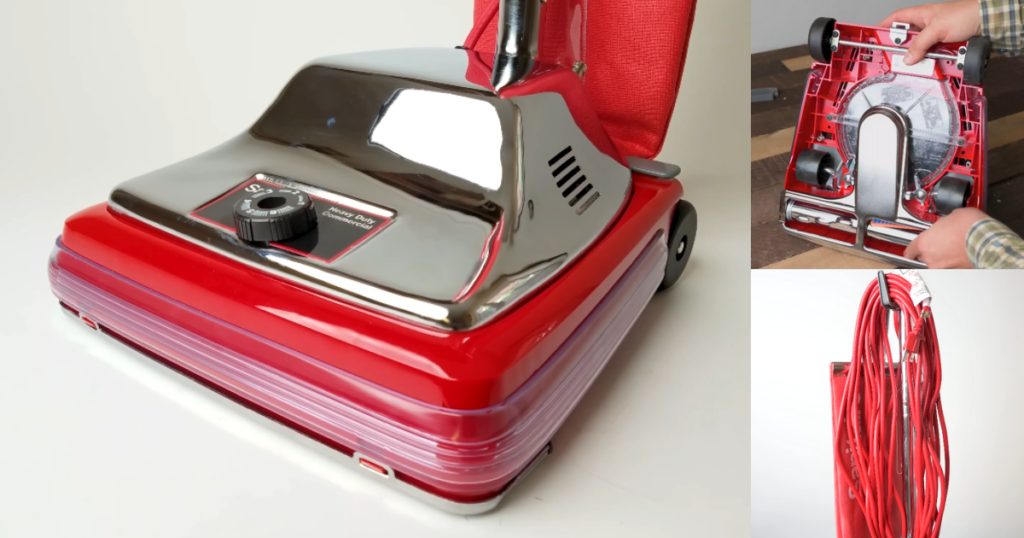
A homeowner might appreciate a sleek retractable cord mechanism on a canister vacuum, but a commercial machine is more likely to have a manually wound cord that’s less complex (and if the cord gets damaged, it’s easily replaceable). In fact, some commercial uprights now come with quick-change cord systems – you can unplug and swap the entire power cord assembly in seconds, which minimizes downtime if a cord gets frayed on the job.
Ergonomics & Form Factor
Commercial vacuums are designed for function over form, but since people may use them for hours straight, professional brands do incorporate ergonomic features – just different ones than residential vacuums. For example, commercial models often have adjustable handles or looped grips for comfort during long use, and some are specifically shaped to reduce strain (backpack vacuums are the prime example of ergonomic design to reduce user fatigue [insideadvisorpro.com]). They also tend to have much longer power cords – 35, 50, even 75 feet – so that large rooms can be cleaned without constantly searching for outlets [insideadvisorpro.com]. By comparison, a typical home vacuum cord might be ~20–30 feet. The longer cord can be a minor annoyance in a small home (having to coil it), but in a big commercial space it’s a huge efficiency gain.
Vacuum Cord Lengths Comparisons
| Vacuum | Type | Cord Length |
| Oreck Commercial Professional | Commercial | 40 ft |
| Hoover Commercial HushTone | Commercial | 40 ft |
| Hoover Commercial TaskVac Bagless | Commercial | 35 ft |
| Sanitaire SC679K Tradition | Commercial | 30 ft |
| Dyson Ball Animal 3 (see our review) | Residential | 35 ft |
| Shark PowerDetect (see our review) | Residential | 30 ft |
Residential units focus on maneuverability: swivel steering, low-profile heads that can go under furniture, and aesthetic design to look attractive in your closet. Commercial vacuums, as one cleaning industry article analogized, are like a restaurant kitchen appliance vs. a home kitchen appliance – not as pretty, but built for continuous duty [insideadvisorpro.com].
Overall, commercial vacuums sacrifice a bit of convenience and elegance to maximize toughness and coverage, whereas residential vacuums aim for user-friendly features and manageable size/weight for the home environment [blog.mastercraftusa.com]. This difference in design philosophy is evident as soon as you push the machine: the commercial unit feels like a work tool, the residential like a consumer appliance.
Durability and Expected Lifespan
Given their heavy-duty build, it’s no surprise that commercial vacuums usually outlast residential ones when put to the test. Manufacturers and professionals often cite 5 years as a minimum lifespan for a good commercial vacuum under regular daily use, and many can last far longer with proper maintenance [insideadvisorpro.com]. In fact, 10+ years of service is not unusual for top commercial models that are well cared for [insideadvisorpro.com]. They are engineered to endure heavy foot traffic, frequent movement, and demanding cleaning tasks day in and day out [blog.mastercraftusa.com]. The motors in commercial machines are typically rated for more hours of operation before burning out. Housings, fans, and brush rolls can take more of a beating without failing.
Residential vacuums, even high-quality ones, are generally not built with the same “forever” mindset. Many home vacuums start to show wear after a few years of weekly use – belts stretch, battery capacity on cordless units drops, or plastic parts might crack if mishandled. Of course, there are premium residential brands (e.g. Miele, Sebo, Kirby) known for long-lasting machines that can approach commercial durability, often at a high price point. But the average affordable home vacuum ($100–$300 range) is not expected to last a decade. It’s telling that some cleaning professionals actually buy certain residential models for commercial use because they are cheap enough to replace frequently. For example, a cleaning crew might buy several $200 Shark or Bissell vacuums for light duty and just replace them annually, instead of a single $800 commercial unit – but the trade-off is more downtime and less performance. In general, if you follow the intended usage: a commercial vacuum in a business vs. a residential vacuum in a home, the commercial will run far more hours over its life and thus is built to handle that without failing.
One reason for this longevity is serviceability – commercial vacuums are designed to be repaired rather than discarded. Spare parts like belts, brush rolls, motors, cords, and filters are usually available for years, and often the design allows easy access to those parts. A user on a vacuum forum noted that a classic Sanitaire commercial upright “is easily repaired and parts are cheap”, with simple replacement of wear items like roller brushes when needed [youtube.com]. In contrast, many modern residential vacuums (especially cordless sticks) are not very repairable – when the battery or motor dies, you may end up buying a new unit because labor or parts are too costly.
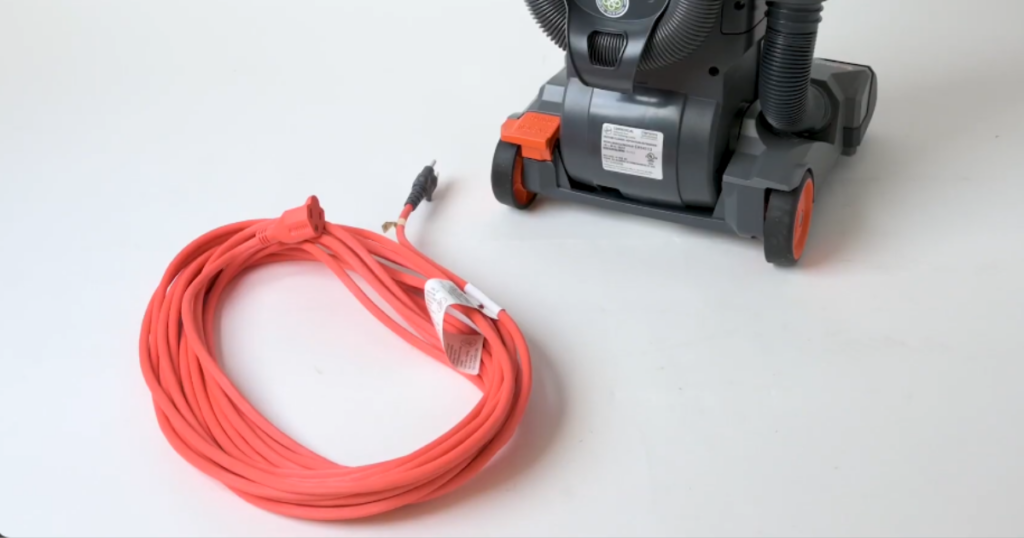
To quantify durability: one guide states “a good commercial vacuum should last you at least five years… you may get 10 or more years from the best models”, emphasizing to check reviews and warranties to gauge a model’s longevity [insideadvisorpro.com]. Residential vacuums often come with warranties around 1–5 years depending on brand (Dyson offers 5-year on uprights, Shark around 5 for some models, cheaper brands maybe 1–2 years). Commercial vacuum warranties can also vary (some just 1 year, others 2–3 years for parts), but the real measure is how they hold up beyond warranty under constant use. Sanitaire uprights, for instance, are well known in the janitorial industry to “run forever” if you maintain them – some cleaning companies have units 15+ years old still in service.
In summary, you can expect a longer service life and more resilience from a commercial vacuum. For a small business owner, that durability can justify the higher upfront cost because it won’t be replacing the vacuum as often [popularwoodworking.com]. As a homeowner, one might not need such extreme longevity, but if you have a large house or heavy shedding pets (i.e. you use your vacuum a lot), investing in a more durable model – even a commercial-grade one – could pay off in the long run.
Suction Power and Cleaning Performance
When it comes to raw cleaning ability, both commercial and residential vacuums can pack a punch – but they often approach it differently. Commercial vacuums are engineered for heavy-duty performance: they tend to have powerful motors and strong suction to pick up dirt from high-traffic areas [blog.mastercraftusa.com]. Many commercial uprights use high-amperage motors (7 to 12 amps is common) and are very effective at deep carpet cleaning. For example, the Sanitaire SC888 traditional upright has a 7-amp motor that, combined with its direct air design, can move about 145 CFM (cubic feet per minute) of airflow [thinkvacuums.com] – that high airflow helps pull up embedded grit from carpets.
In comparison, a typical residential upright like the Dyson Ball Animal 3 (see our review) has extremely high sealed suction (Dyson cites ~290 Air Watts of suction power) but its airflow at the floor head might be lower than the Sanitaire’s (Dyson’s technology relies on strong suction and agitation from the brush bar to deep clean) [dyson.com].
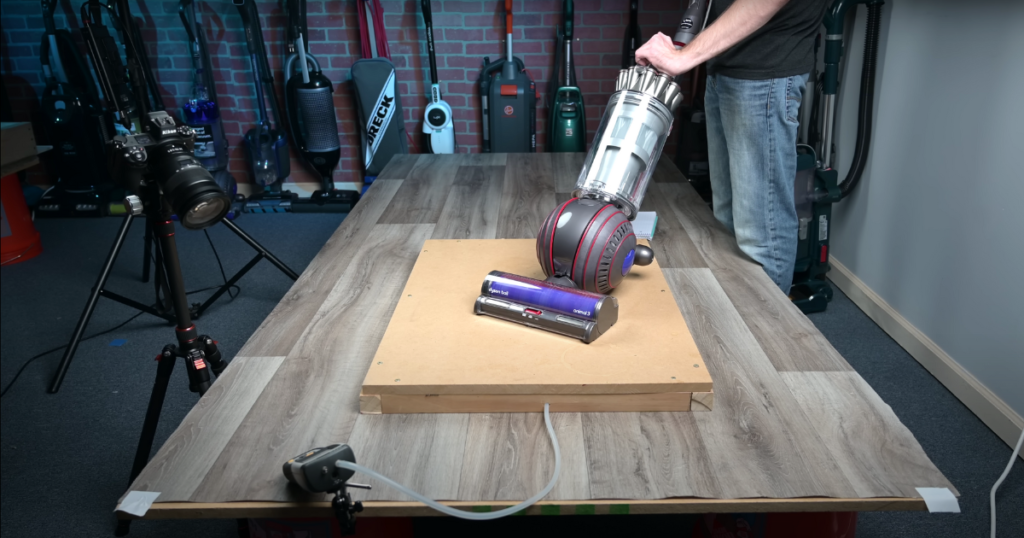
In short, commercial vacuums often excel in either airflow or suction in order to tackle certain tasks: some have dual motors (one driving the brushroll, one for suction) to ensure consistent pickup even on dirty, worn carpets [insideadvisorpro.com].
Residential vacuums, especially newer designs, use advanced technology to improve cleaning without always increasing motor size. Cyclonic separation, powered brushrolls with anti-tangle features, and self-adjusting heads (like on the Dyson Ball) help them clean a variety of surfaces well. A high-end home vacuum can certainly rival a commercial unit in suction specs – for instance, the Dyson Ball Animal 3’s motor is so strong it can literally lift rugs off the floor with its suction, and it’s rated as having the “strongest suction of any vacuum” at the time of its release.
But raw power isn’t the only factor. The use-case focus matters: commercial vacuums often prioritize carpet cleaning and large debris removal. They might not perform as well on fine dust or hard floors unless specifically designed for it. In fact, many commercial uprights lack a brushroll shutoff or a hard-floor mode, meaning they tend to scatter debris on hard surfaces. Chris White, CEO of Vacuum Wars has observed this gap, saying: “very few commercial vacuum cleaners are good for hard floors.” He notes that commercial models are usually “much heavier and more awkward and limited” in their application, often 10–15 years behind in terms of technology – meaning some modern multi-surface innovations haven’t been adopted widely in the commercial space yet (more on this in the Features section) – even though they do offer excellent durability and parts availability.
On the flip side, residential vacuums aim to be all-rounders: you can take the same vacuum from your carpeted living room to your kitchen tile. Many have adjustable suction or brushroll controls to handle different floor types. A good residential vacuum can outperform a commercial one on certain tasks like picking up fine dust from a hard floor or cleaning delicate rugs, because the commercial unit wasn’t optimized for that (it might have stiff brushes only meant for carpet, etc.).

However, for the core task of removing dirt from carpets (especially wall-to-wall carpet in large areas), commercial vacuums often have the edge in sustained performance. They are designed to maintain suction even as the bag fills (big dust bags don’t clog as quickly, and motors don’t overheat with continuous use). A user review of a Hoover HushTone commercial upright illustrates this deep-clean power: “it is great at carpet deep cleaning… [after vacuuming] the first bag was pretty full of sand, dust and grit” that had been left behind by prior vacuums [vacuumland.org]. This underscores how commercial machines can pull out embedded debris that perhaps lighter residential vacuums missed, especially in high-traffic or neglected carpets.
To put it simply, commercial = heavy-duty performance for the big jobs, residential = versatile performance for mixed tasks. If you have specific needs like lots of thick carpet and shedding pets, some residential vacuums (e.g. Dyson Animal, Shark Stratos or Bissell MultiClean) will come with tools and features to excel at that, but a commercial vacuum like a Sanitaire will let you vacuum all day without skipping a beat. Interestingly, we’re seeing a bit of crossover: some commercial models now incorporate better multi-surface capability (for example, the Vacmaster UB0402 commercial upright touts a brushroll that can handle hard floors as well as carpets [vacuumwars.com], and conversely some consumer brands (like Shark) have started marketing their high-tech uprights for “professional” or commercial use in small businesses [insideadvisorpro.com]. Shark’s POWERDETECT upright is one example: it’s basically a feature-rich home vacuum (with dual rollers and dirt sensing) that is being positioned as a commercial option due to its robust cleaning tech [insideadvisorpro.com]. This shows that the gap in performance is narrowing as technology trickles into both sides.
A Note on Wet/Dry and Specialty Vacuums
It’s worth mentioning wet/dry vacuums (shop-vacs) and other specialty industrial vacuums as part of performance: these are generally commercial/industrial machines designed to handle water, large debris, or hazardous dust. A home might have a small wet/dry vac in the garage for DIY messes, but in commercial use, wet/dry capability is crucial for things like construction cleanup or workshop use [insideadvisorpro.com] [blog.mastercraftusa.com]. These vacuums trade finesse for raw utility – they have very powerful suction and can suck up liquids or heavy debris, but they’re not used on carpets or fine cleaning. We mention them because if you’re a business owner dealing with those messes, a regular residential vacuum would not survive or perform well (and could even be dangerous if used on water). So, performance needs might dictate a completely different class of vacuum for commercial needs.
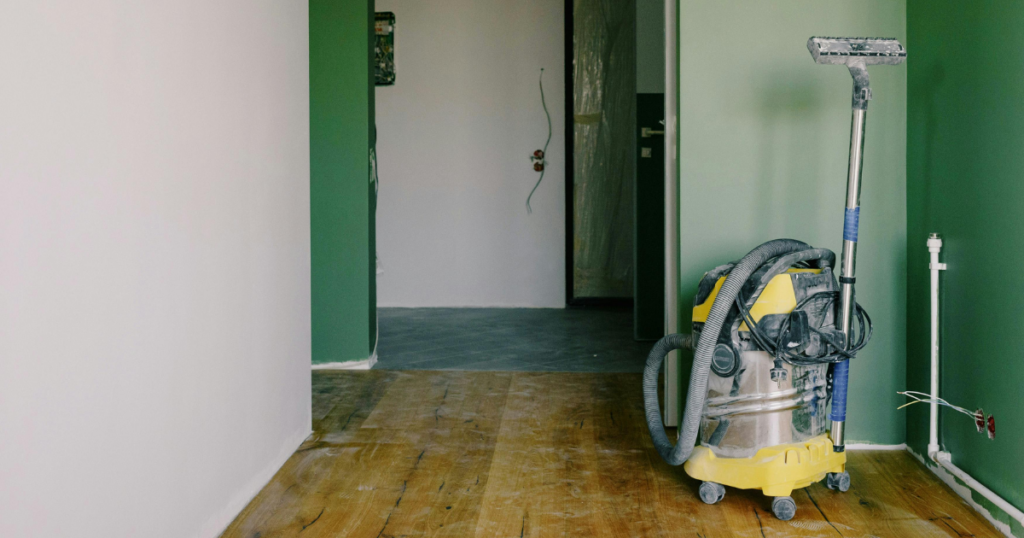
Filtration and Allergen Control
Maintaining indoor air quality is important for both homes and businesses, but it’s often critical in commercial settings like offices, hotels, or hospitals. Commercial vacuums often prioritize advanced filtration systems, including the use of HEPA filters (High-Efficiency Particulate Air), to trap fine dust and allergens [blog.mastercraftusa.com]. In environments with lots of people (and thus lots of skin particles, hair, dirt being brought in), or sensitive locations (healthcare facilities, cleanrooms), you’ll find commercial vacuums equipped with multi-stage filtration. For example, many ProTeam backpack and upright vacs use a 4-stage HEPA filtration system that can capture 99.97% of particles down to 0.3 microns, ensuring dust isn’t being blown back into the air [insideadvisorpro.com]. Even in general office or retail use, having a good filter is a plus because it means less dust resettling on surfaces after vacuuming.
Residential vacuums also come with good filtration nowadays, especially mid-range and high-end models, but there’s a bit more variability. Some cheap home vacuums might use a basic foam or cartridge filter that doesn’t seal all fine dust (so you get that “vacuum smell” of dust after cleaning). Higher-end residential vacs often advertise HEPA filters, whole machine filtration, or “allergen lock” bags, which indeed can approach the filtration of commercial machines. The difference is often in the seal: commercial vacuums are usually designed as sealed systems so that all air goes through the filter, whereas consumers will want to be doubly certain that their residential model is fully sealed (dust can leak around seals if not well engineered).
Professionals tend to trust commercial machines to truly improve air quality. One cleaning equipment blog noted that “commercial vacuums typically have a variety of filtration methods… many have multiple filtration systems for extra protection”, and that pros often opt for HEPA to avoid just blowing dust around [insideadvisorpro.com] . It also mentions that HEPA filtration is ideal for reducing allergies and asthma concerns [insideadvisorpro.com] – relevant to both homes and workplaces.
Another aspect is capacity and dust handling. Commercial vacuums, especially those with bags, hold a lot of debris (some upright bags hold 4–6 quarts of dust, and canister tanks even more) [thinkvacuums.com]. This means the filtration system has to cope with a large volume of dirt without clogging. Often, commercial units will have shake-out cloth bags or use large disposable paper bags that act as the first filter stage (catching the big stuff) and then secondary filters (motor filters, HEPA cartridges, etc.). Residential vacuums that are bagless rely on cyclonic action to separate dust, and then have filters for the fine particles. Cyclonic systems (like Dyson’s famous multicyclone) keep performance up as the bin fills, but their filters still need periodic cleaning. In contrast, a commercial bagged vacuum can often fill an entire bag and still maintain airflow, then you just toss the bag. For someone with allergies at home, a bagged HEPA vacuum (possibly even a commercial one) can actually be a smart choice to minimize dust exposure when emptying.
Noise Levels and Operation
Noise is an often overlooked factor when choosing a vacuum. Vacuum cleaners can be loud, and that affects users and anyone nearby. In a home, you might tolerate a noisy vacuum for 15 minutes of cleaning, but in a commercial setting like a hotel or office, a loud vacuum could disrupt people. Here’s how commercial and residential vacuums stack up on noise:
- Residential Vacuums: The average home vacuum operates in roughly the 70–80 dB range [ecovacs.com] [johnnyvac.com] – about as loud as an alarm clock or a garbage disposal. Uprights and older models tend to be on the higher end of that. Some premium residential canisters are quieter; for example, certain Miele vacuums are known to run around 60–65 dB on lower power settings (quiet enough to talk over). But many popular bagless uprights (Dyson, Bissell, etc.) are quite loud at full power. Noise isn’t usually a make-or-break for home buyers, but if you have pets or family members sensitive to noise, it’s a consideration. Robot vacuums, for what it’s worth, are generally quieter (50–70 dB), which is one reason people let them run while at home.
- Commercial Vacuums: In the commercial arena, there’s actually been a push in recent years for low-decibel vacuums to enable “daytime cleaning” (vacuuming while customers or employees are present without causing too much disturbance). Many commercial vacuums advertise a decibel rating. According to a CleanLink industry report, “Most low-decibel upright vacuums operate at around 70 decibels, while backpacks and canisters are as low as 50.” [cleanlink.com]. That 50 dB level for a backpack or canister is impressively quiet – roughly like a normal conversation. How can a commercial vacuum be so quiet? Often by using noise-dampened motors, better insulation, and by running at lower power settings when needed. Some commercial vacuums have multiple speed settings or a “quiet mode.” For example, the Hoover HushTone commercial upright has a normal mode and a quiet mode; in quiet mode it runs around mid-60s decibels to allow cleaning in noise-sensitive areas, and can bump up the power (and noise) only when nobody’s around. The CleanLink article noted that certain models can run at 50 dB on low (using ~350 watts) and then up to 60–70 dB on high power (using ~900+ watts) [cleanlink.com].
That said, not all commercial vacuums are quiet – some heavy-duty ones don’t bother with noise reduction. For instance, the Sanitaire upright we discussed registers about 79 dB at the operator’s position [thinkvacuums.com], which is basically the same as a typical loud home vacuum. Many older design commercial machines prioritize performance and durability, with noise being a secondary concern. In an industrial environment, a loud vacuum might not matter; in a 24/7 hotel, it matters a lot. So, commercial options diverge: you have specialty quiet models and you have basic brute-force models.

For home users, vacuum noise is mostly a comfort issue (and possibly an issue with scared pets!). For business users, noise can affect when and where you can vacuum. If you can only clean after hours, noise might be less of an issue. But for day cleaning, it’s important. Manufacturers like Nilfisk and Kärcher produce commercial canister vacuums with sound-dampening specifically for use in occupied spaces, often hitting that <60 dB range.
In practical terms, if you run a small business (say a boutique or a clinic) and want to vacuum during business hours, investing in a quieter commercial model could be worthwhile for customer comfort. If you’re a homeowner in a small apartment, you might also appreciate a quieter vacuum (your neighbors certainly will). There are residential canister models advertised as ultra-quiet too – it’s not an exclusively commercial feature. But if we generalize: commercial vacuums tend to either be as loud as a normal vacuum or specially engineered to be quieter than normal, while residential vacuums are usually around “normal vacuum loudness” unless you specifically buy a quiet model.

One more consideration: ear protection. Extremely loud vacuums (above ~85 dB) used for long durations can warrant hearing protection. Some industrial vacuums or shop-vacs can exceed 85–90 dB. Users in commercial settings sometimes wear ear plugs if running such equipment for hours. Thankfully, most modern commercial floor vacuums stay below that threshold, and day-cleaning trends push for quieter machines to avoid any hearing strain in the first place [cleanlink.com].
Features and Attachments
When it comes to bells and whistles, residential vacuums often lead the way. Home vacuum manufacturers are in a fierce competition to win consumers with convenience features and innovation: flashy LED headlights, swivel steering, auto cord rewind, Wi-Fi connectivity in some robot vacs, you name it. Commercial vacuums, in contrast, typically emphasize functional features that aid cleaning productivity and safety, rather than high-tech gadgets. Let’s break down some feature differences:
Attachments & Tools
Almost every residential vacuum comes with a set of attachments (crevice tool, dusting brush, upholstery tool, etc.) to tackle above-floor cleaning. Many uprights have hoses or lift-away canisters to use these tools on couches, drapes, or car interiors. Commercial vacuums vary – some commercial uprights do not include onboard attachments at all (to keep the unit lighter and simpler, or because they assume you’ll use a separate tool for above-floor cleaning) [sanitairecommercial.com]. Others, especially commercial canisters and backpacks, do come with a range of tools (crevice, floor wand, etc.), but they might not store on the unit nicely like a home vacuum. The idea in commercial use is often that the operator carries a toolkit or the tools are back in the cleaning cart, rather than clipped to the vacuum. However, certain commercial uprights (like the ProTeam ProForce 1500XP) integrate a hose and wand so the user can quickly do edges or above-floor areas without switching equipment [insideadvisorpro.com].
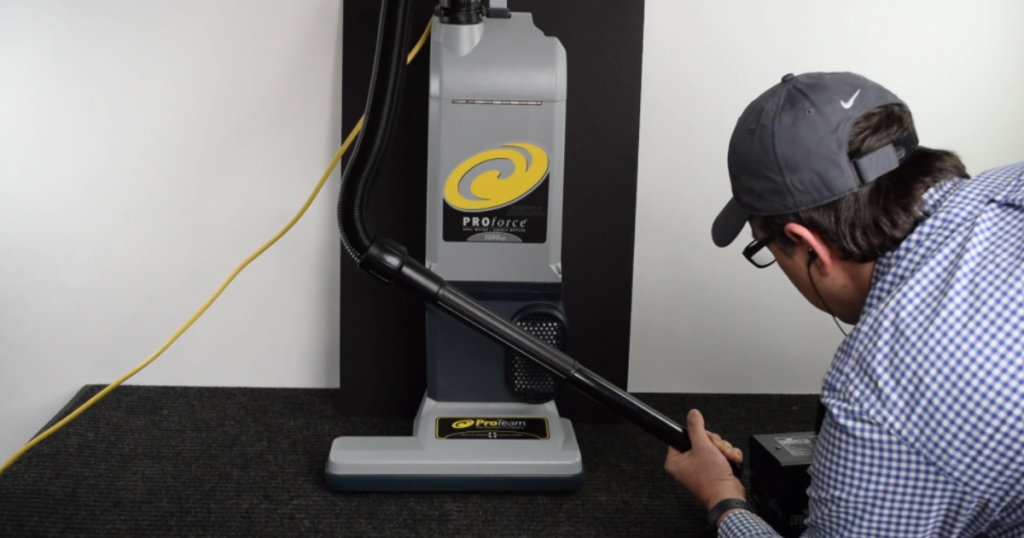
In general, home vacuums might have more specialized pet hair tools or powered mini-brushes for stairs, etc., whereas commercial setups have basic but effective attachments sized for quick use. A blog on Mastercraft (a cleaning equipment company) notes that “commercial vacuums come equipped with a wide range of specialized cleaning tools… catering to specific needs of commercial environments” [blog.mastercraftusa.com], whereas “regular vacuums provide a more limited set… focusing on common household cleaning requirements.” [blog.mastercraftusa.com]. This suggests that if anything, commercial vacs can have a lot of tools available, but a given model might not include all of them by default. They often let the buyer choose specific attachments for their needs.
Adjustability & Controls
Residential uprights often have automatic height adjustment for different carpet piles or a switch to turn off the brushroll for bare floors. Many commercial uprights, surprisingly, stick to manual height adjustment (a knob or lever to set the brush height) or have no height adjustment at all, especially if they are meant just for low-pile commercial carpet. The rationale is simplicity and one less thing to break. Some commercial vacuums (like certain Hoover Commercial models) do have multiple height settings or even auto-adjust, but it’s not a given. Speed control is another – most home vacuums are single speed (some canisters have a dial for suction control, though). Commercial machines, if they have dual modes, it’s often to provide a quiet mode vs. full power mode as mentioned earlier [cleanlink.com].
Technology & Innovation
Here’s where Chris White’s insight comes in. He pointed out that “commercial vacuums are often 10 or 15 years behind in terms of technology”, largely because there’s not as much investment in R&D in that category. This is evident if you compare a cutting-edge Dyson, like the Dyson Gen5detect (see our review) or Shark PowerDetect (see our cordless or upright reviews) to a typical commercial vacuum: the Dyson might have laser dust detection, a dynamic load sensor for its motor, and an app telling you how many particles it picked up – whereas the commercial vacuum is essentially the same design it was a decade ago: an on/off switch and a sturdy motor. Why the gap? Businesses value proven reliability and ROI over fancy new features, and the market for commercial machines is smaller and more conservative. As Chris noted, “I don’t think there’s a lot of money going into research and development in the commercial vacuum space.” Instead, improvements tend to be incremental – e.g., slightly better filtration, more ergonomic handles, adding a cord clip – rather than the kind of sweeping innovations we see in consumer models.
| Vacuum | Specs |
| Dyson Gen5detect Cordless – Residential | Auto Suction Adjustment, Active Hair Removal, Motorized Handheld Brush, Detachable Battery, LED Lights, Laser Light, LCD Screen, Digital Battery Life Display, Particle Collection Display |
| Shark PowerDetect Upright – Residential | Edge Detect, Floor Detect, Dirt Detect, Direction Detect, Swivel Head, Anti Tangle, LED lights, Powered Lift Away, Duster Crevice Tool, Self Cleaning Pet Brush |
| Hoover HushTone Upright – Commercial | Performance Indicator, ScatterGuard Squeegee, Easy-Access Brushroll & Belt System, Clean-Drop Bag, Bypassed Air System |
Chris White goes on to say, “ And though they do offer more parts and more durability, they are usually much heavier and more awkward and limited — for example, very few commercial vacuum cleaners are good for hard floors. … That being said, there are advantages for business owners, and I’m not sure that there is much of an alternative for them at the moment. … There are some good options out there.”
Chris encapsulates the trade-off: commercial units lag in tech (no surprise when you look at a typical gray-colored commercial vac that still uses disposable bags and basic switches), but they deliver on the practical needs of businesses (durability, serviceability). He also hints that business owners need those advantages and currently don’t have many alternatives if they want the combination of heavy-duty and long-lasting – though some newer “good options” are appearing, likely referring to those few models that try to bring advanced features into commercial use.
Examples of Feature Differences
A concrete example: Dyson’s residential vacuums have whole-machine HEPA filtration, one-click bagless emptying, a rotating ball joint for steering, and even things like a laser in the newest stick vac to reveal dust on hard floors. In contrast, a Sanitaire commercial upright has none of those – it’s a bagged unit, you manually adjust the height, no swivel (it goes straight back and forth), and emptying involves removing and replacing a paper bag. However, the Sanitaire does have advantages for the commercial user: it holds far more dirt (so you empty it less often, important for efficiency), its “Micron” filter bags can trap 99% of fine dust so it can meet cleanliness standards [thinkvacuums.com], and it has tool-free access for maintenance (you can swap the belt or brush roll in a minute without a screwdriver) [sanitairecommercial.com] [thinkvacuums.com] – features a home user might not care about, but a technician or janitor values greatly.
Corded vs. Cordless
In the consumer world, there’s a huge trend toward cordless vacuums for convenience. Dyson has even declared it will focus on cordless and eventually phase out corded models for home use. In commercial cleaning, corded is still king because of the need for continuous runtime. A few commercial-grade cordless vacuums have appeared (like Sanitaire’s TRACER backpack or ProTeam GoFree battery backpack), which allow ~45–60 minutes of cleaning per charge – useful for certain situations like spot cleaning or areas without outlets. They are expensive due to the battery tech. For now, most businesses use corded vacuums (or ride-on floor sweepers for huge areas). The stick cordless vacs dominating homes are rarely used commercially, except perhaps by a maid service in a small house where dragging a cord is inconvenient. Even then, many prefer a lightweight corded like an Oreck Commercial upright (which is basically a simple 8-pound corded vacuum often used in hotels for quick cleaning). Until battery technology improves to give multi-hour continuous use and quick swapping, corded vacuums will remain the norm in large-scale cleaning.
Other Niche Features
Some commercial vacuums come with interesting niche features tailored to specific needs: for instance, units with ultraviolet (UV) lights to sanitize as they vacuum (useful for healthcare or mold remediation), or built-in magnets on the front to pick up paperclips and nails in workshops so they don’t puncture the bag or get left on the floor [insideadvisorpro.com]. You generally won’t see UV sanitizers on a home vacuum (though some home robot vacuums tried adding UV lights briefly). Similarly, wet capability or anti-static grounding (for vacuuming fine toner or explosive dust) are features found only in commercial/industrial machines.
In essence, residential vacuums focus on convenience features and multi-surface versatility, while commercial vacuums focus on features that boost productivity and reliability. If you’re an informed consumer, you might drool over the latest gadget on a Dyson or Shark, but if you’re outfitting a cleaning crew, you’ll probably pick the model that has the features that matter for completing jobs faster (long cord, big bag, maybe a cord clip and a simple reliable switch – less to go wrong). The two categories are designed with different end-users in mind: homeowner vs. professional.
Maintenance and Repairs
Maintenance is a fact of life for any vacuum, but how it’s handled differs greatly. Commercial vacuums are designed to be maintained regularly and repaired when needed, whereas many residential vacuums are treated as semi-disposable (use until it breaks, then replace).
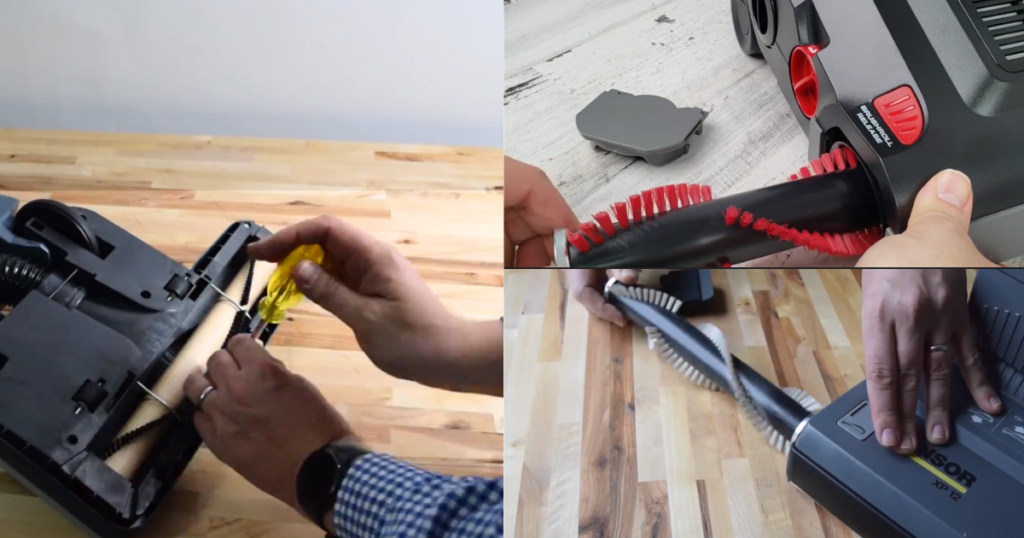
Maintenance Frequency
In commercial use, vacuums often get preventative maintenance. If you run a cleaning service, you might change the belt on each vacuum every few months, replace filters on a schedule, and keep spare parts handy. One recommendation from Sanitaire for their commercial units is to change belts every 6 months and brushroll yearly for optimal performance [thinkvacuums.com]. This ensures the vacuum always cleans effectively – critical when clients expect professional results. Home users, in contrast, may forget to even check the brushroll until something goes wrong. They might clean filters or replace a belt only when suction drops noticeably. Residential bagless vacuums often need filter washing or dust cup cleaning, which some owners dutifully do and others ignore (leading to reduced performance or motor strain).
Ease of Repairs
Commercial machines score big here. They are built to be user-serviceable or service-shop-serviceable with relative ease. An example: the Sanitaire TRADITION upright has a quick release cover to access the belt and brushroll, requiring no tools [sanitairecommercial.com]. The cord on many commercial uprights is external and detachable – if it’s damaged, you can unplug it and snap in a new cord assembly in seconds, rather than opening up the vacuum. Parts availability is another aspect: brands like Sanitaire, Hoover Commercial, and ProTeam supply parts (motors, fans, switches, hoses, etc.) often for many years, and because the designs don’t change drastically year to year, parts are interchangeable across model revisions. This is deliberate; as one review of commercial vacs put it, “the classic Sanitaire is easily repaired and parts are cheap”[youtube.com]. Residential vacuums, especially from big box brands, can be harder to repair. Often, finding the exact part for your specific model variant can be challenging unless it’s a popular model with aftermarket support. Some high-end residential brands (e.g. Miele, Sebo) do have excellent parts availability and even authorized service centers, almost like commercial units. But many people simply don’t repair home vacuums – if the motor burns out after 5 years, they buy a new vacuum rather than fixing it. Cost plays a role: a new mid-range vacuum might cost $200, whereas a motor replacement could be $100 plus labor, making replacement more attractive. Commercial vacuums generally cost more, so there’s more incentive to repair a $500 machine than a $50 Walmart special.
Downtime and Redundancy
Businesses often have multiple vacuums and will rotate or keep spares. If one needs service, it’s not a big problem because a backup is on hand. A homeowner typically has just one main vacuum (and maybe a small hand vac). If it breaks, you’re without a vacuum until it’s fixed or replaced. That’s another reason professionals value easy repair – it minimizes downtime and cost. For a homeowner, downtime is an inconvenience; for a business, downtime can mean a floor didn’t get cleaned on schedule. So the stakes for maintenance are different.
User Error and Abuse
Commercial vacuums anticipate rough handling. They assume different operators will use them (some might be rough, bang into things, run over the cord). Thus, things like thermal cut-off switches (to shut the motor if it overheats from a clog) are built-in, and many commercial units have indicator lights or clear panels to show if something is jammed. Residential vacuums also have thermal protection these days, but older ones could just burn out if misused. If you have employees, you want a machine that won’t break the first time someone sucks up something they shouldn’t. A lot of commercial designs use more forgiving “bypass” motors (clean-air design) or have wide pathways so clogs are less common, whereas some residential designs with narrow air paths can clog if someone tries to vacuum large debris or lots of hair without cleaning the filters.
Filter and Bag Changes
In commercial settings, bags are usually changed very frequently – often every day or every few days, even if not completely full, to ensure maximum suction for the next use. The cost of bags is just part of the supplies, like vacuum “consumables.” In residential, people often try to stretch bag changes to save money, or empty bagless cups only when they’re brimming. This difference in maintenance culture means a commercial vacuum may perform optimally more consistently, while a home vacuum might sometimes be running in a semi-clogged state because the owner forgot to wash the filter last month.
To sum up, commercial vacuums are built for and expected to undergo regular maintenance, with easy part swaps and robust construction to withstand it. Residential vacuums are often less maintenance-intensive by design (trying to be “maintenance-free” for a period), but when something goes wrong they’re harder to fix. If you’re a homeowner who doesn’t mind a bit of maintenance, a commercial vacuum could actually be refreshing to use – easy to unclog, easy to change the bag – but you’ll need to remember to do those tasks. If you’re not the type to replace belts or clean filters, you might prefer a residential model that at least guides you (many have indicator lights for filter clean or will shut off if the brushroll is jammed, etc.).
Price and Value
Finally, let’s talk dollars. Commercial vacuums typically come with a higher upfront price tag than residential vacuums, but the value proposition is different. You’re paying for longevity and service, not necessarily fancy features or looks. Residential vacuums range widely in price – you can find a $50 stick vac or a $1,000 premium canister. Commercial vacuums also range widely, but tend to start at a higher baseline for a good unit.
Upfront Cost
A solid commercial upright from a reputable brand (Hoover, Sanitaire, etc.) often costs around $300–$600. For example, the ProTeam ProForce 1500XP dual-motor upright we mentioned lists for over $500 on Amazon at this time. A durable commercial backpack like the ProTeam Super CoachVac might be in the $400–$600 range. There are also more affordable commercial models – some basic Sanitaire or Bissell commercial uprights can be found in the low $200s or even under $200 for stripped-down versions. On the upper end, specialty commercial/industrial vacuums (like Nilfisk HEPA vacs or battery-powered models) can run $800–$1,500+. For instance, a Nilfisk GM80 HEPA canister (an industry-standard for laboratory cleaning) costs around $800, and a high-capacity wet/dry or hazardous dust vacuum can cost a few thousand dollars. Comparatively, residential vacuums can be very cheap – you can get a workable upright for $100-$200 or less – or quite expensive (Dyson’s top models $500–$800, Miele’s deluxe canisters around $1,200 with all attachments).
Operating Costs
Commercial vacuums, being often bagged, incur ongoing cost for bags and replacement filters. These are usually priced reasonably (since commercial buyers will buy them in bulk). Residential vacuums that use bags (like some Kenmore, Miele, etc.) also have this cost; bagless ones shift the cost to maybe filter replacements or just time spent cleaning them. Battery replacements for cordless vacs are another cost (a new battery pack for a Dyson might be $100, every few years). In a business, these maintenance costs (bags, filters, belts) are part of the budget, whereas a homeowner might be annoyed to spend $20 every few months on bags. It’s worth noting: some commercial vacuums are intentionally bagless or have reusable shake-out bags to reduce operating costs. For example, Sanitaire has models with a cloth shake-out bag that you empty and reuse, specifically to avoid buying bags – useful for companies that want to minimize consumables. But most today use paper bags for better filtration and less mess.
Value and ROI
The value of a commercial vacuum is measured in how much cleaning it can do over its life. If a $500 commercial vacuum lasts 7 years doing daily cleaning of a 10,000 sq ft facility, and a $200 residential vacuum would only last 1 year in the same environment, the commercial vac actually is cheaper in the long run and avoids the hassle of frequent replacement [popularwoodworking.com]. For a home user, spending $500 on a vacuum only makes sense if it provides a clear benefit (better cleaning, lasts longer, etc.) over a $150 model. Often, it does – higher-end vacuums do tend to clean better and last longer – but each person’s budget is different. Small business owners often face a decision: “Can I use a residential vacuum to save money?” The answer might be yes for a very small office or low-traffic environment (or if you, say, run a bed and breakfast and are okay replacing a cheaper vacuum more often). But as Bissell’s commercial FAQ advises, generally it’s “not recommended” for businesses to rely on residential vacuums because the durability, versatility, and improved cleaning of commercial units make them a better fit and likely save money over time[bissellcommercial.com]. Conversely, should a homeowner buy a commercial vacuum for home? If you have a large house or want something to truly last a long time, it can be a good investment, but for most average-sized homes, a quality residential vacuum will be tailored better to consumer needs and may cost less.
Brand Pricing Examples
Let’s mention some vacuum brands and compare price ranges:
- Hoover offers residential uprights like the WindTunnel series often under $200, while Hoover Commercial has models like the HushTone and TaskVac in the $250–$400 range depending on features (the HushTone with multi-speed and HEPA might be on the higher end). [https://hoover.com/]
- Bissell is known for very affordable home vacuums (often <$150 for uprights), but their Bissell BigGreen Commercial line includes some pricier items like industrial drum vacs or the Bissell Big Green carpet cleaner machine (around $400). [https://www.bissell.com/]
- Dyson and Shark are mainly residential-focused; Dyson uprights ~$400–$600 new, Dyson sticks $300–$750 depending on model; Shark uprights ~$200–$400. These brands don’t really have a separate commercial line (though Shark uses the term “Professional” on some home models and Dyson sometimes markets to businesses for small-scale use of their standard products). [https://www.dyson.com/] [https://www.sharkninja.com/]
- Sanitaire (a brand under Electrolux for commercial vacuums) has a range: their basic traditional uprights can be $200–$300, and their more advanced models with features (like QuietClean series with better filtration, or cordless units) can be $400+. [https://www.sanitairecommercial.com/]
- ProTeam, which targets commercial/pro users exclusively, tends to be mid-high range: $400 for a backpack, $600–$800 for uprights or specialized vacs, but they’re built very well and usually include a set of tools. [https://proteam.emerson.com/]
- Nilfisk and other industrial brands (Kärcher, Tennant, etc.) often have premium pricing ($500 and up easily) as they cater to institutions and have very specific models for certain tasks. [https://www.nilfisk.com/]
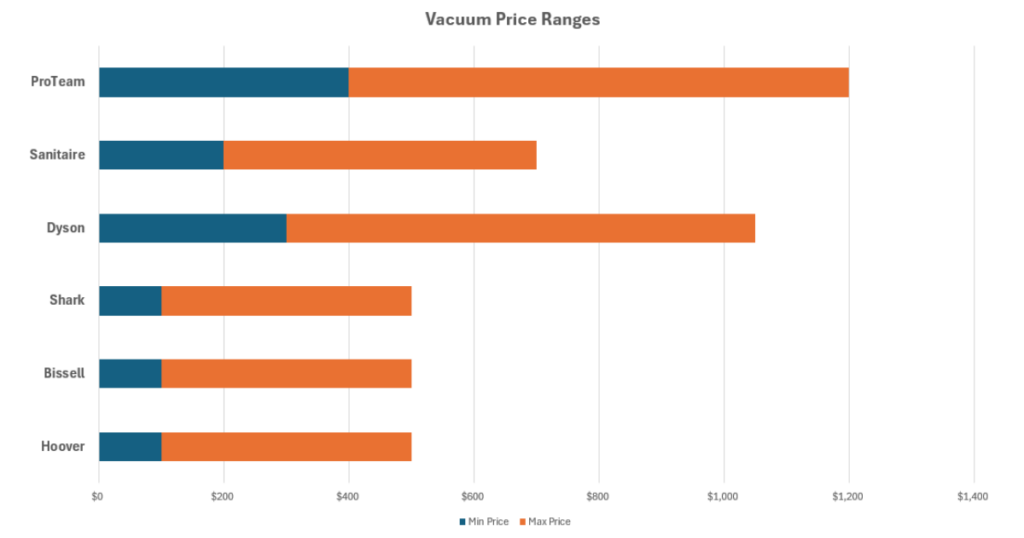
In terms of value, reputable sources and reviews often highlight that you “get what you pay for” with vacuums. Consumer Reports and others note that the very cheapest vacuums often have poor performance or break quickly. At the same time, the most expensive isn’t always the best for your needs. It’s about matching the vacuum to your requirements. A small cafe might spend $300 on a commercial canister and have it last years, whereas a residential vacuum might choke on the daily crumbs after a short time. One guide summed it up: “Commercial vacuums offer features that set them apart… larger dust capacities, longer power cords, and more robust motors.” [commercialcleaningdepot.com] These features contribute to a higher cost, but if those are features you need, they are worth it. If you don’t need them, a less expensive residential model might suffice.
To help visualize, below is a comparison table of a popular residential vs. commercial upright vacuum, showing how their specs and features stack up, which also reflects differences in price and design:
Upright Vacuum Comparison: Residential vs. Commercial
| Feature | Dyson Ball Animal 3 (Residential) | Sanitaire TRADITION SC888 (Commercial) |
|---|---|---|
| Weight | 17.3 lb (8 kg) – fairly heavy due to motor & “Ball” design for stability | 18 lb (8.2 kg) – heavy-duty build with metal components |
| Cord Length | 35 ft cord – standard length for home upright | 50 ft cord – extra-long for large areas, with quick-change feature |
| Dust Capacity | 1.7 L bin – bagless, clear bin shows dirt level | 1.5 gal (5.8 L) dust bag – large disposable paper bag (or shake-out cloth bag) |
| Filtration | Advanced whole-machine HEPA filtration (traps 99.97% of 0.3 μm); washable lifetime filter | Allergen “Micron” filter bag (captures ~99% of dust/pollen); optional HEPA bags available |
| Floor Adjust | Self-adjusting cleaner head (auto adapts from carpet to hard floor); motorized brushroll | Manual 6-position height adjust for different carpet heights; no hard-floor setting |
| Attachments | Yes – hose and wand with multiple tools (combo tool, stair tool, turbine tool for pet hair) | Typically no – SC888 is floor use only; other Sanitaire models offer tool options |
| Noise Level | ~80 dB (estimated) – loud on carpets; no official spec but considered “noisy” | 79 dB at operator position – similarly loud; no quiet mode |
| Notable Features | Ball steering; bagless one-touch empty; modern design; 290 AW suction; 5-year warranty | Extremely durable; easy maintenance; proven commercial design; 2-year warranty |
| Approx. Price | $400–$500 – premium home vacuum reflecting tech and brand | $300 – mid-range commercial price; fewer frills but long-term value |
Of course, there are many models in each category – but this comparison highlights typical differences: the Dyson brings convenience and multi-surface versatility; the Sanitaire brings stamina and simplicity.
For another perspective, here’s a brief comparison of canister/backpack vacuums in residential vs. commercial form:
Canister/Backpack Vacuum Comparison
| Feature | Miele Complete C3 Canister (Residential) | ProTeam Super CoachVac Backpack (Commercial) |
|---|---|---|
| Weight | ~11–13 lb canister + hose – lightweight design, follows on floor | 11 lb unit – worn on back; weight distributed via harness |
| Cord | 24 ft cord with automatic retractable rewind | 50 ft cord – manually wrap; long reach for commercial rooms |
| Capacity | 4.5 L (1.2 gal) dust bag – large for home use, self-sealing bags | 9.5 L (2.5 gal) dust bag – huge capacity, fewer bag changes during big jobs |
| Filtration | Sealed system with HEPA filter (99.99% capture) – excellent for allergy sufferers | 4-stage filtration with HEPA media – designed to maintain air quality in offices/schools |
| Floor Tools | Multiple high-quality attachments: parquet floor brush, electric powerhead (in some models), crevice, upholstery, dust brush | Commercial tool kit: multi-surface floor head, crevice tool, dusting brush, upholstery tool – no motorized brush |
| Noise | Very quiet: ~60–70 dB on low settings – Miele canisters are known for quiet operation | Moderate: ~66 dB – relatively quiet with a constant hum |
| Notable Features | Electronic suction control, one-touch cord rewind, polished design, multiple model options (e.g. Cat&Dog version) | Ergonomic harness, usable while walking, high airflow (~150 CFM), requires training for cord management |
| Approx. Price | $900 – $1,100 (with power brush) – premium canister with top-notch filtration and accessories | $500 – $600 (with full tool kit) – professional machine offering high productivity |
These examples and tables illustrate that the core differences in price often stem from what you’re paying for – advanced convenience and multi-functionality (in residential) versus rugged efficiency and longevity (in commercial).
Conclusion and Key Takeaways
For an informed consumer or a small business owner, choosing between a commercial and residential vacuum cleaner comes down to understanding your cleaning needs and priorities:
- Durability vs. Convenience: If you need a vacuum that will run for hours daily and last years with proper care, a commercial model is likely worth the investment – it will be built to handle that workload [bissellcommercial.com]. If your cleaning tasks are lighter duty or you value cutting-edge features and ease of use (like lightweight design, bagless emptying), a residential vacuum may serve you better.
- Design Differences: Commercial vacuums are generally heavier, louder (in some cases), and more utilitarian in design, with longer cords and larger capacities [insideadvisorpro.com]. Residential units aim to be user-friendly – smaller, lighter, often more stylish, with convenient storage for attachments.
- Performance: Both categories can clean well, but commercial vacuums shine in specific scenarios (large carpeted areas, continuous use, heavy soil) while residential vacuums are optimized for versatility (handling both carpet and hard floor in a home, dealing with pet hair on furniture, etc.). Suction and airflow are strong in both, but you’ll often see higher airflow and simple but powerful brushrolls in commercial machines for deep carpet cleaning [thinkvacuums.com] [vacuumland.org], versus high suction and tech-driven brush heads in residential units for all-floor performance.
- Features: Residential vacuums come packed with the latest innovations – if you love tech, you’ll appreciate things like smart sensors, LED lights, and maybe even app integration on some robot vacs. Commercial vacuums stick to proven features that directly aid cleaning efficiency (long cords, durable parts, sometimes dual-motor systems) and usually skip the flashy extras. As Chris White noted, commercial models lag in adopting new technology, which can make them feel “old school” but also means they’re using time-tested designs less prone to glitches.
- Filtration: Both can offer HEPA filtration, but commercial vacuums often incorporate it because of stricter cleaning standards in public/commercial spaces [blog.mastercraftusa.com]. Many residential vacs also offer HEPA now – ensure it’s a sealed system for best results if allergies are a concern. For environments like hospitals or labs, you’d lean towards true commercial HEPA-rated machines (e.g., Nilfisk, ProTeam).
- Noise: If quiet operation is crucial (like cleaning during business hours or not waking a baby at home), check decibel ratings. Commercial “quiet” models exist and some are impressively low-noise [cleanlink.com]. Some high-end home vacuums are also engineered for low noise. In general, expect to pay more for a vacuum that balances power with quietness.
- Maintenance: Are you (or your staff) prepared to maintain the vacuum? Commercial units require a bit of routine care (bag changes, brushroll checks, filter swaps) but reward you with consistent performance and long life [thinkvacuums.com]. Residential units require maintenance too, but many users neglect it – leading to reduced lifespan. If you prefer not to think about maintenance much, you might lean towards a bagless residential vacuum (just empty it and clean filter occasionally). If you don’t mind maintenance, a commercial vacuum is straightforward to keep in top shape and parts are accessible if something wears out [youtube.com].
- Budget and Value: For businesses, a vacuum is equipment – spend what you need to get the job done reliably. Over five years, a $500 commercial vacuum that rarely breaks is likely cheaper than replacing a $150 home vacuum every year (not to mention less frustration) [popularwoodworking.com]. For home users, consider how often and intensively you vacuum. It might be worth buying a better-built machine (even if marketed to commercial) if you have a large home or heavy usage, because it could last decades. On the other hand, if you have a small apartment, a mid-range residential vacuum might be perfectly sufficient and more convenient to use and store.
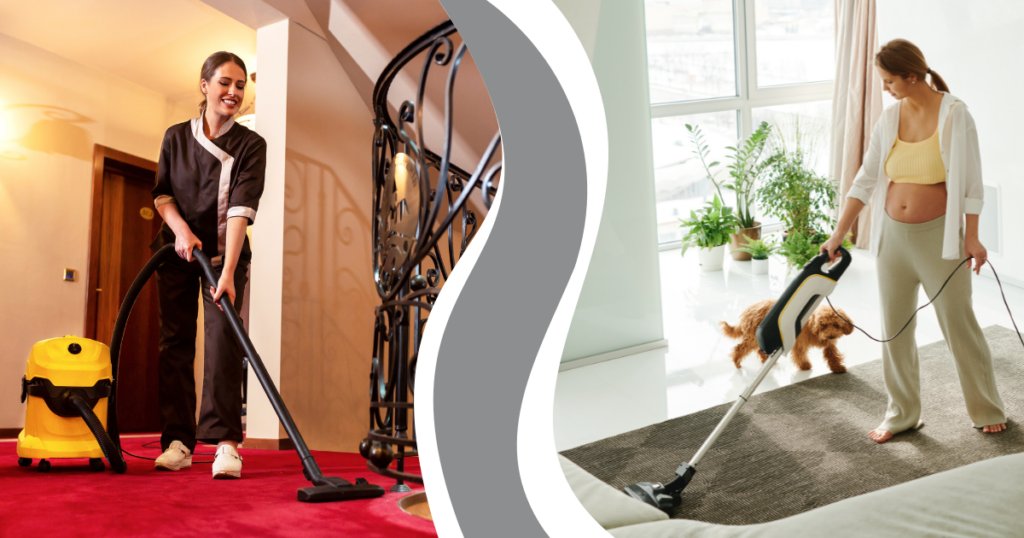
In making your decision, look at reputable reviews and testimonials, such as our years of vacuum reviews on this website. for the models you consider. Professional reviews (from sources like Consumer Reports or Vacuum Wars) will give you performance metrics and reliability data. User testimonials (from customers or on forums) can tell you how a vacuum holds up in real-world use – for instance, a business owner might share that their commercial Oreck has run daily for 5 years with no issues, or a pet owner might rave that their residential Dyson cut cleaning time in half. We included a few such insights: the Vacuum Wars expert highlighting the tech gap but necessity of commercial vacuums, and a forum user praising how a commercial unit pulled out buried carpet dirt [vacuumland.org]. These illustrate that while commercial vacuums might seem old-fashioned or cumbersome, they truly excel at the task they’re built for.
Bottom line: If you’re a small business owner, you’ll likely want the durability, capacity, and perhaps warranty/support of a commercial vacuum – it’s an investment in your operations. If you’re a homeowner, you’ll want a vacuum that fits your lifestyle – maybe that’s a fancy cordless stick for quick daily touch-ups, or maybe it’s even a commercial-grade canister to tackle your big house cleaning every week. There’s also nothing stopping a homeowner from using a commercial vacuum – some people actually prefer it.” As one cleaning blog put it, “Businesses have much higher foot traffic… if you operate 5 days a week, you should consider a commercial vacuum” [bissellcommercial.com], whereas “residential vacuums are specifically designed for [homes]” and usually that specialization is beneficial.
In conclusion, choose the category that aligns with your priority: longevity and toughness (commercial) vs. convenience and innovation (residential). And remember, there are some “crossover” options – for example, Sanitaire makes a lightweight “Professional” series that could suit home users wanting sturdiness, and brands like Shark market “Powered Lift-Away Pro” models that some small businesses use because they offer advanced features with decent (if not full commercial) durability. By understanding the differences outlined above – design, durability, features, weight, power, noise, filtration, maintenance, and price – you can make an informed choice and get the vacuum cleaner that best meets your cleaning needs. Happy vacuuming!
Frequently Asked Questions
What is the difference between a commercial and a residential vacuum cleaner?
Commercial vacuum cleaners are built for heavy-duty use in businesses, prioritizing durability, large capacity, and longer cords. Residential vacuums are designed for home use, offering convenience features, lighter weight, and more advanced technology for multi-surface cleaning.
Can I use a commercial vacuum cleaner at home?
Yes, homeowners can use commercial vacuums, especially if they have large spaces or heavy cleaning needs. Commercial vacuums may lack some residential conveniences but offer unmatched durability and capacity.
Is a bagged vacuum better than a bagless one for commercial use?
Most commercial vacuums are bagged to ensure high capacity, reduced maintenance, and better filtration. Bagless systems are more common in residential vacuums for convenience, but they may require more frequent filter cleaning.
Are commercial vacuums better for pet hair?
It depends. While commercial vacuums offer strong suction and durability, many lack the pet-specific tools found in residential models. High-end residential vacuums often include attachments designed specifically for pet hair removal on upholstery and stairs.
Do commercial vacuums last longer than residential vacuums?
Yes, commercial vacuums are designed to endure frequent, long-term use in demanding environments. With proper maintenance, many can last over 10 years, whereas residential vacuums typically have shorter lifespans with moderate use.
Which type of vacuum is better for carpet cleaning: commercial or residential?
For deep carpet cleaning, commercial vacuums often perform better due to higher airflow and rugged brushrolls. However, premium residential models may offer more versatility for different carpet types and hard floors.
Are commercial vacuums louder than home vacuums?
Not always. Some commercial vacuums are engineered to operate quietly for daytime cleaning in offices or hotels. However, older or heavy-duty commercial models can be as loud or louder than typical residential vacuums.
Why do commercial vacuums use longer cords?
Commercial vacuums often have 40–75 foot cords to reduce downtime by allowing continuous cleaning across large areas without switching outlets. Residential vacuums usually have 20–30 foot cords optimized for smaller spaces.
What features should I look for in a vacuum for business use?
Key features include a long power cord, durable construction, HEPA filtration, high airflow, large capacity, and easy access to replaceable parts. Ergonomic design, such as backpack models, can also improve efficiency in large spaces.
